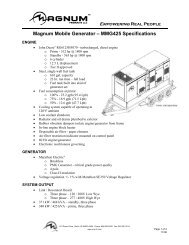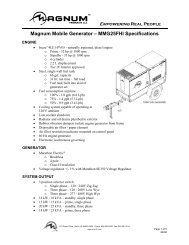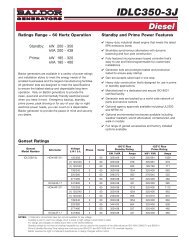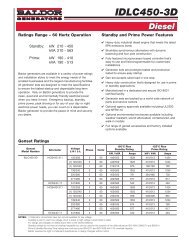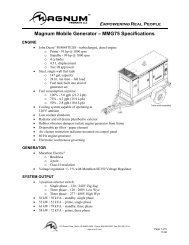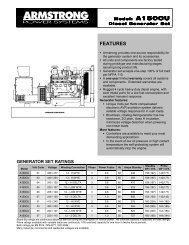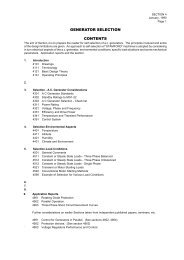GENERATOR SELECTION CONTENTS - Diesel Generator
GENERATOR SELECTION CONTENTS - Diesel Generator
GENERATOR SELECTION CONTENTS - Diesel Generator
You also want an ePaper? Increase the reach of your titles
YUMPU automatically turns print PDFs into web optimized ePapers that Google loves.
SECTION 4111<br />
January, 1990<br />
Page 3<br />
Frequency The frequency of the voltage from an a.c. generator depends on the driven speed and the<br />
number of magnetic field poles, thus:-<br />
Frequency (Hz) = Speed (rev/min) x Poles<br />
120<br />
Note: HZ = Hertz = cycles per second (see a.c.)<br />
Therefore for standard frequencies, the most common combinations of speed and poles are<br />
given below:-<br />
50 Hz 3000 rev/min 2 pole<br />
60 Hz 3600 rev/min 2 pole<br />
50 Hz 1500 rev/min 4 pole<br />
60 Hz 1800 rev/min 4 pole<br />
50 Hz 1000 rev/min 6 pole<br />
60 Hz 1200 rev/min 6 pole<br />
h.p. Horsepower, a measure of the rate of doing work, use by primer mover manufacturers, but now<br />
being replaced by the S.I. unit, kW - see power. A ‘metric horsepower’ C.V. (cheval vapeur) or<br />
PS (pferdestarke) is common in Europe. The relationships are:<br />
1 h.p. = 0.746kW = 33,000 ft lb/min<br />
1 C.V. or PS = 0.735kW<br />
kVA This unit is always the product of voltage and current in single phase a.c. systems. In the<br />
three phase case an extra constant is involved (√ 3 ). It is the normal way of quoting a rating for<br />
any a.c. generator. It is independent of power factor and is only used when considering a c<br />
systems. It is also normal to specify a kVA level at specific power factortherefore defining the<br />
level of real power capability of the machine and its primer mover:-<br />
i.e. kW = kVA x power factor<br />
= real power capability<br />
This specific power factor is conventionally considered to be 0.8 p.f. lagging, although in practical<br />
installations power factors of nearer 0.9 p.f. lagging are usually measured. As systems get<br />
smaller, power factors approaching 0.95 p.f. lagging are obtainable in practice. Since quite<br />
large outputs are obtained from a.c. generators it is conventional to divide the product of voltage<br />
and current by one thousand to obtain the unit kVA.<br />
i.e. 1kVA = 1000VA<br />
kW See power.<br />
V I<br />
In single phase systems kVA = phase x phase<br />
1000<br />
V I<br />
In three phase systems kVA = √ 3 line line<br />
1000<br />
V I<br />
= 3 phase phase<br />
1000<br />
where √3 = 1.732<br />
Magnetic Field A force set up around a magnet. The best known magnetic field is that of the earth, established<br />
by the North and South magnetic poles.<br />
The existence of a strong magnetic field is a pre-requisite of an a.c. generator. The magnetic<br />
field can be produced by using a permanent magnet material or by electrical methods. A d.c.<br />
supply is necessary for setting up a magnetic field electrically, commonly called an excitation<br />
supply. The magnetic field strength can be varied by varying the d.c. excitation supply. The<br />
number of magnetic field poles must be multiple of 2, as each ‘magnet’ comprises a North pole<br />
and a South pole. The most common poleages for a.c. generators are 2 pole, 4 pole or 6 pole.<br />
See also Frequency.<br />
Nominal A range of operating conditions or values within which the machine can be safely and successfully<br />
run. See also Rating.



